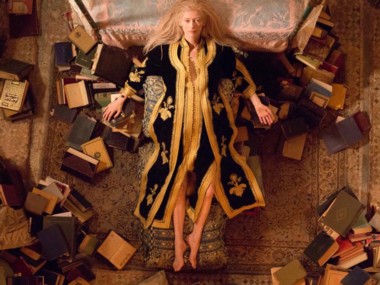You might have thought that the current craze for all things vampiric had run its course. Over the last few years—further, if you track it back to the Buffy The Vampire Slayer era—we have seen all manner of pop culture infiltrated by those creatures of the night. Of course, none have had quite the impact that the Twilight series has had, at least among the 12- to 14-year-old set.
That Sweet Valley High take on the romantic legend seemed to be the final nail in the coffin of the current trend, but this week an unusual film makes a late entry into the game. From a director best known as an art-house darling, Jim Jarmusch’s (Broken Flowers, The Limits of Control) story hopes to inject a bit of life into an increasingly bloodless genre.
Only Lovers Left Alive is his new film, screening this week at Amherst Cinema. A perfectly cast Tilda Swinton (The Grand Budapest Hotel) stars with Tom Hiddleston (Loki in the recent Thor and Avengers films) as Adam and Eve, vampires whose love story has already spanned several centuries. Reunited in modern-day Detroit (with some jaunts to Tangier), the pair find that the world around them, for all its technological breakthroughs, is beginning to crumble.
Partially inspired by the last book published by Mark Twain (The Diaries of Adam and Eve), Jarmusch’s film is as unconventional a love story as that of Twain’s original pair. But here there is no casting out of the Garden; instead, the rest of the world seems to creep in, until the line between outside and in is no longer noticeable, and not for the better. In this modern world, the old lovers are forced to think about bloodborne diseases, more vigilant authorities, and the 24-hour news cycle.
Like vampires from day one—or night one, perhaps—this Adam and Eve are outsiders, forced to hide from the day. But they find some solace: in our era, being a night owl means they can blend with the more interesting humans—musicians, artists, intellectuals—who are drawn to the later hours and would rather talk than sleep. In that way, Jarmusch’s film is less about two mythological creatures that feast on our blood, and more about our own tortured outsiders, and what the future looks like for them in a time that places less and less value on the creativity that so often pushes them toward the dark.
Also this week: Director Tomas Leach’s film In No Great Hurry is the story of one of those creative types. Saul Leiter was a photographer who is today recognized as one of the pioneers of the New York School of photography, which flourished in the 1940s and ’50s (Diane Arbus and Robert Frank are its best-known stylists). But while Leiter was making some breakthrough work in color photography, his personality was such that he never felt the urge to chase success, even when it would have been his for the asking. Instead, he went his own way, amassing a giant archive of work that ends up in towering piles around his New York apartment. But despite his indifference—when Leach first visited to ask the photographer about making a film, Leiter’s response was “Why do people always want something from me?”—fame catches up with Leiter in his 80s. Leiter passed away at the end of last year, but his work will live on for years yet to come.•
Jack Brown can be reached at cinemadope@gmail.com.



